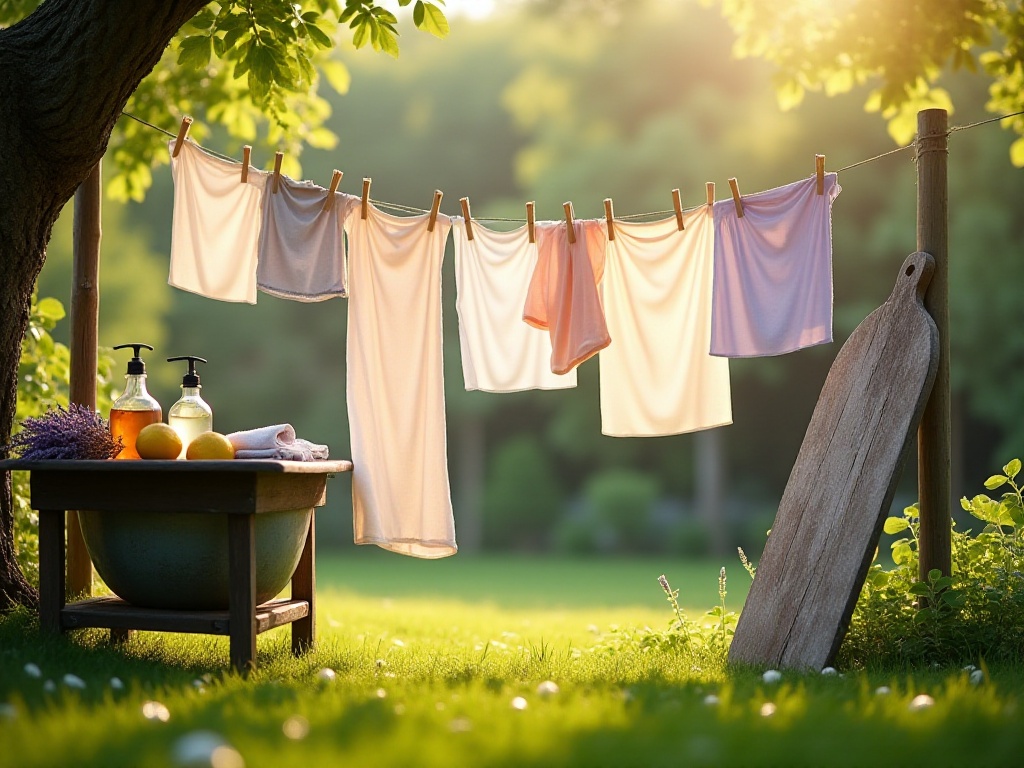
Introduction
Have you ever experienced this embarrassing situation: your new clothes lose their "divine beauty" and become "ordinary" or even unwearable after just a few wears? Your favorite hoodie's sleeves got deformed after washing, your beloved white T-shirt turned yellow after a few washes, and that expensive sweater shrunk so much it could only fit your younger siblings...
As someone who's been doing their own laundry since college, I've made countless mistakes. After years of practice and research, I've finally mastered some "professional laundry secrets." Today, I'm sharing these valuable tips to help you keep your clothes looking better with each wash, while saving money and being environmentally friendly!
Initial Preparation
What's the most important aspect of doing laundry? It's not how premium your detergent is or how smart your washing machine is, but the preparation work. Just like applying primer before makeup, laundry requires proper groundwork.
First, let's talk about sorting clothes, which is absolutely crucial! I once made a huge mistake: throwing a new red T-shirt in with a bunch of white socks. Guess what happened? All the white socks turned pink! Since then, I've become extremely careful, strictly sorting clothes into three categories: dark colors (black, navy, dark gray, etc.), light colors (light pink, light blue, beige, etc.), and pure white.
Besides color sorting, fabric sorting is equally important. Different fabrics are like friends with different personalities - some are gentle as water, others are tough and sturdy. Delicate fabrics like silk and wool shouldn't be washed with rough items like jeans and canvas shoes. Otherwise, the delicate silk might get damaged by metal buttons on jeans, and soft wool sweaters might get tangled with shoelaces and lose their shape.
I now sort clothes into these categories: 1. Delicates: Silk, lace, pure silk, and other high-end fabrics 2. Knitwear: Sweaters, wool garments, and other items prone to deformation 3. Cotton items: T-shirts, shirts, underwear, and other daily wear 4. Heavy items: Jeans, coats, and other durable clothing

Stain Treatment
Stain treatment is truly a profound science. Different stains require different treatment methods, just like different illnesses need different prescriptions.
The most troublesome are yellow armpit stains on white shirts. I used to love wearing white shirts, but the armpits would turn yellow quickly, looking quite untidy. Later, I discovered a super effective method: make a paste with lemon juice and baking soda, apply it to the yellow stains, wait 15 minutes, then wash normally. This method is a lifesaver, easily removing stubborn yellow stains.
Another crucial principle: treat stains immediately! For example, if you accidentally spill coffee on your clothes, don't wait until you get home. Immediately use tissues to absorb the surface coffee, then treat it with a portable stain remover pen. I always kept a stain remover pen in my bag - it's truly a lifesaver.
Oil stains are also many people's nightmare. Once, I accidentally splashed oil on my new white dress at a hot pot restaurant and almost cried. Later, I used a home remedy: immediately sprinkle some talcum powder (or food starch), wait 10 minutes for the powder to absorb the oil, then gently brush it off. After dry cleaning, the dress was as good as new - I couldn't have been happier!

Water Temperature Selection
Many people think hot water cleans clothes better, but this is actually a misconception. Except for white clothes and bedding that need warm or hot water for disinfection, most clothes are better washed in cold water.
Why? First, cold water washing greatly reduces color fading and deformation. Especially for dark-colored clothes, cold water helps maintain the color longer. Second, cold water washing is more environmentally friendly and energy-efficient. Hot water washing consumes a lot of electricity for water heating, while cold water saves this energy.
However, I should remind everyone that water temperature shouldn't be too low in winter. If the water temperature is below 10 degrees Celsius, the cleaning effectiveness of detergent will be greatly reduced. In cold winter, it's recommended to use room temperature water (15-20 degrees Celsius) to wash clothes, which both protects the clothes and ensures cleaning effectiveness.

Cleaning Products
When it comes to detergents, there's a lot to learn. There are various washing products in the market, including regular liquid detergent, powder detergent, laundry pods, etc. How should we choose?
First, liquid detergent and powder detergent each have their advantages. Liquid detergent dissolves quickly and is less likely to leave residue on clothes, making it especially suitable for cold water washing. Powder detergent has stronger cleaning power, suitable for particularly dirty clothes. I usually choose based on how dirty the clothes are: liquid detergent for daily wear, powder detergent for post-exercise clothes or particularly dirty items.
Many people like to use extra detergent, thinking it cleans better. This is completely wrong! Excess detergent won't make clothes cleaner; instead, it will leave residue in clothing fibers, causing clothes to become hard, smelly, and potentially cause skin allergies.
So how much detergent should we use? I've summarized a simple calculation method: - 3-4 kg clothes: one cap of liquid detergent - 5-6 kg clothes: one and a half caps of liquid detergent - 7-8 kg clothes: two caps of liquid detergent
If clothes are particularly dirty, you can increase the amount by 25%, but never use too much!
Besides basic detergent, I'd like to recommend several particularly useful laundry auxiliary products:
-
Fabric softener: Makes clothes softer and removes static electricity, especially useful in dry winter. Note that sports clothes shouldn't use softener as it affects the fabric's sweat-wicking function.
-
Oxygen-based bleach: This is particularly effective for white clothes, removing yellow stains and various stubborn stains. But note, it can't be used on delicate fabrics like silk and wool.
-
Stain remover: Recommended for every household, used for treating localized stubborn stains like collar and cuff stains.

Special Techniques
When it comes to special techniques, I must share these unique tricks I've discovered over the years.
First is the technique for dark clothes. Many people encounter the problem of dark clothes, especially black ones, becoming whitish after washing. There's actually a very simple method: turn dark clothes inside out before putting them in the washing machine. The principle is that the right side of the clothes will receive less friction, thus reducing color fading.
Jeans care is also a key point. Many people find jeans look worse with each wash, but that's because of incorrect washing methods. Jeans are best hand-washed in cold water, and shouldn't be rubbed vigorously. After washing, don't wring them out; hang them directly to dry. This maintains the texture of denim and keeps jeans looking better with wear.
Wool sweater cleaning also needs special attention. Many people have experienced wool sweaters shrinking, but this can be completely avoided. When washing wool sweaters, water temperature must be kept below 30 degrees Celsius, and special wool detergent should be used. After washing, gently press with a towel to absorb water, then lay flat to dry - this prevents deformation and shrinkage.

Post-Wash Care
Post-wash care is equally important. Many people use dryers for convenience, but this greatly shortens the lifespan of clothes.
Natural air-drying is the best choice. However, there are techniques to air-drying: - Dark clothes should avoid direct sunlight, best dried in shade - White clothes can be dried in sunlight for natural bleaching effect - Sweaters should be dried flat to avoid deformation from hanging - Shirts are best hung on hangers to reduce wrinkles
If natural air-drying isn't possible, when using a dryer, note these points: - Use moderate temperature, not too high - Don't over-dry; leaving slight moisture is better - Underwear and delicate fabrics should preferably not go in the dryer

Storage Methods
Many people think storage is just folding clothes and putting them in the closet? That's a big mistake! Proper storage methods not only keep your closet neater but also maintain clothes in better condition.
I now use the "rolling" storage method. Roll T-shirts, sweaters, and other clothes, and store them vertically in drawers. This has several benefits: - Saves space, can store 30% more clothes than regular folding - Easy to access without messing up other clothes - Reduces wrinkles, no need for ironing
For suits and coats, always use professional hangers. Choose wooden or thick plastic hangers to maintain clothes' shape. Also, ensure space between clothes for air circulation.

Extending Lifespan
Regarding extending clothes' lifespan, the most important point is: not all clothes need washing after each wear!
Jeans are a typical example. Unless particularly dirty or smelly, jeans can be worn 3-5 times before washing. Excessive washing actually makes jeans lose their original texture.
The same applies to suits. After wearing, first gently brush with a clothes brush to remove surface dust. If there are no obvious stains, hang in a ventilated place overnight, and it can be worn again the next day.
However, note that underwear and close-fitting sportswear must be changed and washed promptly. This relates to personal hygiene and shouldn't be neglected.

Final Words
Through this detailed sharing, I believe everyone has gained a new understanding of laundry. Doing laundry is truly an art - mastering the correct methods not only keeps clothes looking new but also contributes to environmental protection.
Remember, each piece of clothing has its unique personality and temperament; we need to treat them appropriately. This not only makes clothes last longer but also keeps us looking our best every day!
How do you usually do your laundry? Do you have any unique tips to share? Let's exchange ideas and make our clothes look their best!
Next
Confessions of a Nutritionist: How I Used Scientific Methods to Help 100 Patients Improve Their Eating Habits
A comprehensive guide exploring healthy eating habits and clothing care, covering nutritional principles, dietary control, and eco-friendly garment maintenance methods for a healthy and sustainable lifestyle
After Three Years, I Finally Figured Out How to Do Laundry - Here's What I Learned
A comprehensive guide to clothing care, covering daily washing classification, special fabric maintenance, stain and odor removal, drying and storage techniques, helping readers master scientific clothing care methods to extend garment life
Save Your Precious Wardrobe: Laundry Tips to Keep Your Clothes Looking New
A comprehensive guide to clothing care covering sorting methods, pre-treatment techniques, washing instructions, drying and storage solutions, and effective stain removal methods for various fabric types
Next

Confessions of a Nutritionist: How I Used Scientific Methods to Help 100 Patients Improve Their Eating Habits
A comprehensive guide exploring healthy eating habits and clothing care, covering nutritional principles, dietary control, and eco-friendly garment maintenance methods for a healthy and sustainable lifestyle

After Three Years, I Finally Figured Out How to Do Laundry - Here's What I Learned
A comprehensive guide to clothing care, covering daily washing classification, special fabric maintenance, stain and odor removal, drying and storage techniques, helping readers master scientific clothing care methods to extend garment life

Save Your Precious Wardrobe: Laundry Tips to Keep Your Clothes Looking New
A comprehensive guide to clothing care covering sorting methods, pre-treatment techniques, washing instructions, drying and storage solutions, and effective stain removal methods for various fabric types


